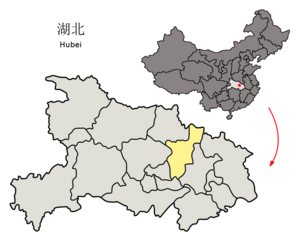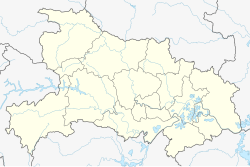
Back مدينة إكسياوجان، هوبى Arabic Xiaogan Catalan Háu-gāng CDO Xiaogan (kapital sa prepektura) CEB Siao-kan Czech Xiaogan Danish Xiaogan German Xiaogan Spanish Xiaogan Basque شیاوگان Persian
Xiaogan
孝感市 Siaokan | |
|---|---|
 view west towards city's south central area | |
 Location of Xiaogan City in Hubei and the PRC | |
| Coordinates (Xiaogan municipal government): 30°55′05″N 113°57′25″E / 30.918°N 113.957°E | |
| Country | People's Republic of China |
| Province | Hubei |
| Municipal seat | Xiaonan District |
| Area | |
| • Prefecture-level city | 8,922.72 km2 (3,445.08 sq mi) |
| • Urban | 1,034.8 km2 (399.5 sq mi) |
| • Metro | 1,034.8 km2 (399.5 sq mi) |
| Population (2020 census)[1] | |
| • Prefecture-level city | 4,270,371 |
| • Density | 480/km2 (1,200/sq mi) |
| • Urban | 988,479 |
| • Urban density | 960/km2 (2,500/sq mi) |
| • Metro | 988,479 |
| • Metro density | 960/km2 (2,500/sq mi) |
| GDP[2] | |
| • Prefecture-level city | CN¥ 145.7 billion US$ 23.4 billion |
| • Per capita | CN¥ 29,924 US$ 4,804 |
| Time zone | UTC+8 (China Standard) |
| Postal code | 432100 |
| Area code | 712 |
| ISO 3166 code | CN-HB-09 |
| Website | www |
Xiaogan (Chinese: 孝感; pinyin: Xiàogǎn) is a prefecture-level city in east-central Hubei province, People's Republic of China, some 60 kilometres (37 mi) northwest of the provincial capital of Wuhan. According to the 2020 census, its population totaled 4,270,371, of whom 988,479 lived in the built-up (or metro) area of Xiaonan District.
The city name Xiaogan, meaning Filial Piety Moves Tian (Chinese: 孝行感天), is from the story of Dong Yong, who sold himself for his father's funeral, in The Twenty-four Filial Exemplars.[3]
The Sheshui River originates in Xiaogan's Dawu County. On the third day of the third month of the lunar calendar, many in Wuhan eat 'di cai zhu ji dan' (地菜煮鸡蛋) which is supposed to prevent illness in the coming year. This practice is related to a story involving Shennong in Xiaogan.[4]
- ^ "China: Húbĕi (Prefectures, Cities, Districts and Counties) - Population Statistics, Charts and Map". citypopulation.de. Retrieved 26 November 2021.
- ^ 湖北省统计局、国家统计局湖北调查总队 (August 2016). 《湖北统计年鉴-2016》. 中国统计出版社. ISBN 978-7-5037-7847-6. Archived from the original on 2017-03-01. Retrieved 2017-06-05.
- ^ 孝行感天-孝感的由来. Huaxia.com (in Simplified Chinese). 17 September 2009. Retrieved 27 March 2018.
孝感既为董永故里,其遗址很多,集中分布于两地:今孝感市区和董永曾长期生活过的今孝南区毛陈镇。
- ^ 三月三吃地菜煮鸡蛋能治头痛?专家:可防流感. 长江日报. 2018-04-19. Retrieved 1 May 2020 – via QQ News.
© MMXXIII Rich X Search. We shall prevail. All rights reserved. Rich X Search
